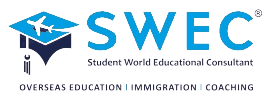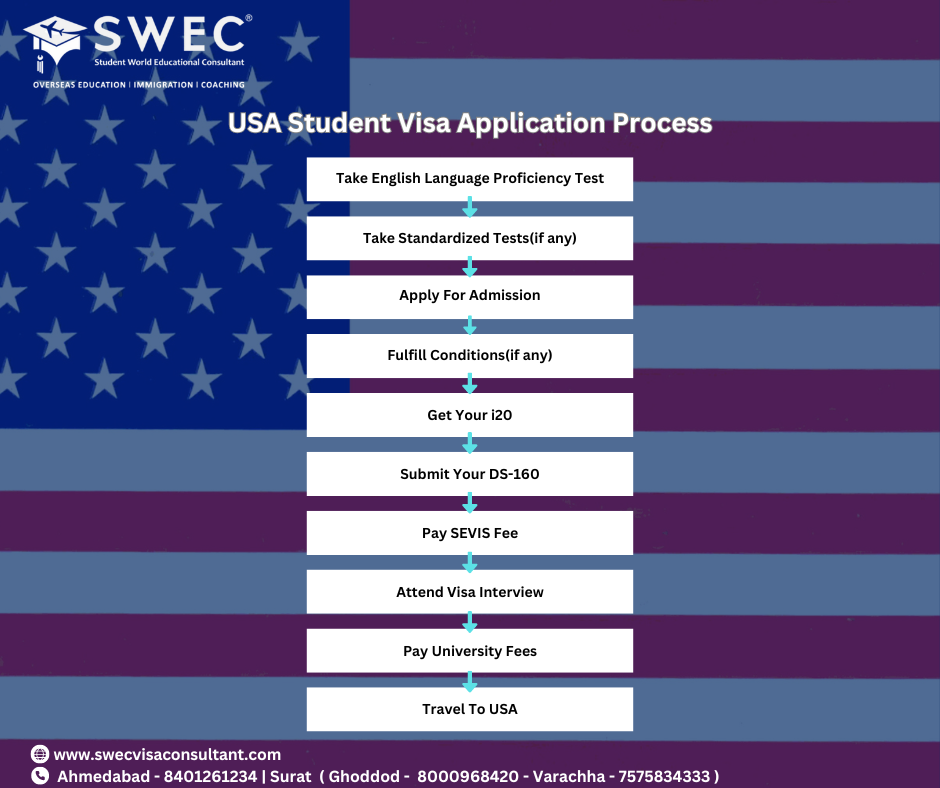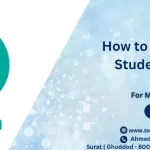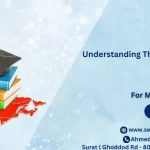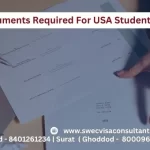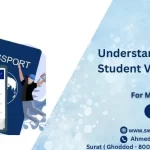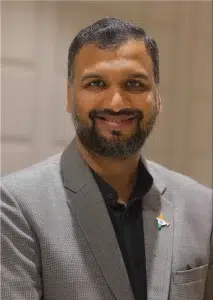The United States continues to be a top destination for international students seeking a world-class education and a vibrant learning environment. If you dream of studying in the US, this comprehensive guide will equip you with the knowledge you need to navigate the US student visa application process in 2024.
This guide simplifies the complexities, offering step-by-step explanations, essential requirements, and valuable tips to increase your chances of success. Whether you’re a high school graduate aiming for an undergraduate degree or a seasoned professional pursuing a postgraduate qualification, this guide will be your companion on the journey to realizing your academic aspirations in the US.
Types of USA Student Visas: M1, J1, F1
When planning to study in the United States, it’s essential to understand the different types of student visas available. Each visa caters to specific types of programs and student needs. Here is a detailed description of the three primary student visas: M1, J1, and F1.
Unleash Your Potential with SWEC, the #1 Ranked US Student Visa Consultants!
Tired of generic advice? SWEC, the top-ranked US student visa consulting firm, is dedicated to helping you excel in your visa application. Our proven strategies and personalized approach have secured success for countless international students. Don’t settle for average – Partner with the best! Schedule a free consultation with SWEC today!
F-1 Student Visa
The F-1 visa is the most common type of student visa for individuals wishing to study in the United States. It is intended for students enrolled in academic programs at accredited institutions, including universities, colleges, high schools, private elementary schools, seminaries, conservatories, and language training programs.
Key Features
- Full-time Study: F-1 students must be enrolled full-time in an academic program.
- SEVP-Approved Institution: The school must be approved by the Student and Exchange Visitor Program (SEVP).
- Duration: Valid for the duration of the academic program plus an additional 60 days for departure.
- Employment: Limited on-campus employment is allowed. Off-campus employment may be permitted with authorization from USCIS, such as Curricular Practical Training (CPT) and Optional Practical Training (OPT).
Application Process
- Acceptance: Receive acceptance from a SEVP-approved school and obtain Form I-20.
- SEVIS Fee: Pay the SEVIS I-901 fee.
- Form DS-160: Complete the online non-immigrant visa application.
- Visa Interview: Schedule and attend a visa interview at the US embassy or consulate.
Benefits
- Extended Stay Options: OPT allows up to 12 months of work experience related to your field of study, with a possible extension for STEM graduates.
- Academic Flexibility: Eligible for a wide range of academic programs and institutions.
M-1 Student Visa
The M-1 visa is designed for students attending vocational or non-academic programs, other than language training. It is suitable for those enrolling in technical courses or vocational schools.
Key Features
- Vocational Training: Specifically for non-academic programs such as mechanical studies, technical courses, culinary classes, and more.
- Fixed Duration: Valid for the length of the program, up to a maximum of one year, with possible extensions for practical training.
- Employment: Limited to practical training related to the area of study and requires authorization from USCIS.
Application Process
- Acceptance: Receive acceptance from an SEVP-approved vocational institution and obtain Form I-20M-N.
- SEVIS Fee: Pay the SEVIS I-901 fee.
- Form DS-160: Complete the online non-immigrant visa application.
- Visa Interview: Schedule and attend a visa interview at the US embassy or consulate.
Benefits
- Specialized Training: Focus on vocational and technical skills.
- Practical Experience: Opportunities for hands-on training in specific fields.
J-1 Exchange Visitor Visa
The J-1 visa is for individuals participating in exchange programs in the United States. These programs promote cultural exchange and provide training, research opportunities, and educational experiences.
Key Features
- Exchange Programs: Includes a variety of programs such as research scholars, professors, and student exchanges.
- Cultural Exchange: Emphasis on promoting cultural and educational exchange.
- Duration: Varies depending on the specific exchange program, ranging from a few weeks to several years.
- Employment: Permitted only as part of the exchange program, with authorization from the program sponsor.
Application Process
- Acceptance: Be accepted into a designated exchange program and obtain Form DS-2019.
- SEVIS Fee: Pay the SEVIS I-901 fee.
- Form DS-160: Complete the online non-immigrant visa application.
- Visa Interview: Schedule and attend a visa interview at the US embassy or consulate.
Benefits
- Cultural Immersion: Opportunities to experience American culture and share your own.
- Broad Opportunities: Applicable to a wide range of exchange programs, including internships, research, teaching, and more.
Documents Required for a US Student Visa
To apply for a US student visa, you will typically need the following:
- Valid Passport: Your passport must be valid for at least six months beyond your intended stay in the US, unless there are country-specific exemptions.
- Acceptance at a SEVP-Approved School: You must have your Form I-20 from the school.
- SEVIS Fee Payment: Proof of payment for the SEVIS application fee.
- Non-Immigrant Visa Application: Completed Form DS-160 confirmation page.
- Photograph: A photograph that meets the specified requirements.
- Optional Practical Training (OPT): If applying for OPT, you need to obtain an Employment Authorization Document (EAD) from USCIS in addition to your Form I-20.
Additional documents that might be required include:
- Academic Preparation Documents: Transcripts, diplomas, degrees, or certificates.
- Financial Evidence: Proof that you have sufficient funds for your living expenses throughout your stay, such as:
- Bank statements
- Sponsor’s financial commitment to cover accommodation and living costs
- Scholarship program details
- Proof of Intent to Leave the US: Evidence like a return air ticket to your home country.
You may also need to attend a personal interview at the US embassy or consulate.
Boost Your Chances of Success with SWEC’s Proven US Student Visa Consulting Strategies!
Navigating the US student visa process on your own can be daunting. SWEC offers proven strategies developed over years of helping students achieve their academic dreams in the US. We will guide you through every step, from application preparation to interview coaching, ensuring you present a strong case for visa approval. Boost your chances of success – Partner with the experts at SWEC!
Why Study in the USA?
- Renowned Universities: Earn a degree from prestigious institutions like MIT, Harvard, or Stanford, known for exceptional teaching, cutting-edge facilities, and globally recognized qualifications.
- Vast Course Selection: Explore a wide range of undergraduate programs across various fields, from engineering and computer science to medicine, arts, and business (refer to the “Popular Courses with Universities in USA after 12th” table below).
- Global Network: Connect with students and faculty from around the world, broadening your perspective and opening doors to international opportunities.
- Practical Experience: Many US universities integrate internships and practical training into their programs, giving you a competitive edge in the job market.
Education System in the USA
The USA boasts around 4,500 accredited higher educational institutions. An undergraduate degree, typically taking four years, is referred to as a Bachelor’s degree. Various types of postsecondary education institutions in the USA include:
| Type of Institution | Key Points | Examples |
| StateCollege/University | Affordable as they are subsidized bystate or local governments. | University of Virginia,University of Michigan |
| PrivateCollege/University | Run by private organizations or groups. | Brown University,Harvard University |
| Community College | Offers two-year associate degrees orcertificate courses. | Green River College,Santa Monica College |
| Institute of Technology | Provides graduate and short-termprograms in engineering, technology,and applied sciences. | MIT, Illinois Institute ofTechnology |
Popular Courses and Universities in the USA
1. Top Science Courses and Universities
| University | QS Rankings 2024 | Popular Courses |
| Harvard University | 5 | Earth and Marine Sciences, Astrophysics, Computer Science |
| Massachusetts Institute of Technology | 1 | B.Sc Chemistry, Architecture, Aerospace Engineering |
| Cornell University | 20 | Agricultural Sciences, Biological Engineering |
2. Top Commerce Courses and Universities
| University | QS Rankings 2024 | Popular Courses |
| Arizona State University | 219 | Accountancy, Business Entrepreneurship, Finance |
| University of California, Berkeley | 27 | Business Administration, Global Management Program |
| Texas A & M University | 164 | Accounting, Agribusiness, Applied Economics |
3. Top Arts Courses and Universities
| University | QS Rankings 2024 | Popular Courses |
| Yale University | 18 | Graphic Designing, Photography, Filmmaking |
| Stanford University | 3 | Art History, Film and Media Studies, Art Practice |
| Dartmouth College | 205 | Music, Studio Art, Film and Media Studies |
4. Top 10 Universities to Study in the USA after 12th
| University | QS Rankings 2024 | Top Bachelor’s Courses |
| Massachusetts Institute of Technology | 1 | Biomedical Engineering, Energy Studies, Entrepreneurship |
| Stanford University | 3 | Business, Earth Sciences, Engineering |
| Harvard University | 5 | Social Sciences, Biology, Computer Science |
| California Institute of Technology | 6 | Biology, Chemistry, Geology |
| University of Chicago | 10 | Econometrics, Mathematics, Public Policy |
| University of Pennsylvania | 13 | Business, Management, Marketing |
| Princeton University | 16 | Engineering, Computer Science, Literature |
| Yale University | 18 | Computer Science, Engineering, Electrical Engineering |
| Cornell University | 20 | Business, Marketing, Biomedical Sciences |
| Columbia University | 22 | Business, Engineering, Medicine |
Eligibility Requirements for Studying in the USA
- Completion of 12th grade with at least 65% or a GPA of 2.53.
- Minimum IELTS score of 6.5 Bands.
- Good scores in standardized tests like SAT or ACT (minimum SAT score of 600800).
- Well written Statement of Purpose and Letters of Recommendation.
- Minimum age of 18 years.
- Acceptance letter from a US university.
Documents Required for Admission Process in the USA
- Educational transcripts
- Valid passport
- Letters of Recommendation
- Statement of Purpose
- University acceptance letter
- English language proficiency scorecard (IELTS/ TOEFL)
- Certificates for extracurricular activities
- Bank statements
- Entrance exam scorecards (SAT/ ACT)
- Work experience letter (if applicable)
Applying To US universities
Applying to US universities can seem overwhelming, but with the right steps and preparation, you can navigate the process smoothly. Here’s a straightforward guide to help you through each phase, from searching for colleges to getting your visa and settling in the US.
Steps to Apply to US Universities
1. Search for Colleges and Courses:
Start by identifying the universities and courses that align with your interests and career goals. Utilize university websites and educational portals for detailed information.
2. Contact Schools and Visit Websites:
Reach out to the admissions offices of the universities you are interested in. Visiting their official websites will provide insights into their admission requirements and campus life.
3. Narrow Down Your List:
Based on your research, create a shortlist of universities that meet your criteria, such as location, course content, and tuition fees.
4. Take Entrance Exams:
Undergraduate Admissions: SAT or ACT
Postgraduate Admissions: GMAT or GRE
English Proficiency Tests: TOEFL or IELTS
5. Write SOPs and Ask for LORs:
Prepare your Statement of Purpose (SOP) and request Letters of Recommendation (LORs) from professors or employers.
6. Apply to Colleges:
Submit your applications to the universities that fit your interests and qualifications.
7. Attend Video Interviews:
Some universities may conduct video interviews as part of their selection process.
8. Apply for a Student Visa:
Once you receive acceptance letters, apply for your student visa.
Maximize Efficiency & Minimize Stress: Choose SWEC for Streamlined US Student Visa Consulting!
The US student visa process can be time-consuming and stressful. SWEC streamlines the application journey, saving you valuable time and minimizing stress. Our dedicated consultants will handle complex paperwork efficiently, ensuring all deadlines are met, and providing clear communication throughout the process. Focus on your studies and let SWEC handle the visa complexities – Choose SWEC today!
Admission Essay for USA
Essays play a crucial role in the admission process. Universities often require one or two essays on topics such as career aspirations, strengths and weaknesses, and reasons for choosing a particular school. These essays help admissions officers understand your personality and motivations.
Statement of Purpose (SOP) for the USA
An SOP is your introduction to the admission officers. Written in the first person, it explains why you are applying to a specific university and how you are a good fit for their program. Make sure to highlight your goals, achievements, and why you are interested in that particular institution.
Letters of Recommendation (LORs) for the USA
LORs are reference letters from professors or managers that describe your qualities, capabilities, and achievements. They support your application by providing a thirdparty perspective on your ability to succeed in your chosen field.
Duration of Courses in the USA After 12th
| Course | Duration |
| Undergraduate Degree | 4 years |
| Associate Degree | 2 years |
| BSc Nursing | 4 years |
Job Opportunities after Bachelor’s in the USA
US universities encourage students to work part-time (20 hours/week) during studies and full-time (40 hours/week) during breaks. Average annual salaries in different fields:
| Job Field | Average Annual Salary (USD/INR) |
| Human Resource | $41,000 $164,000 (INR 13,00,000 1,00,00,000) |
| Accountancy | $35,000 $93,000 (INR 27,00,000 74,00,000) |
| Marketing and Advertising | $54,500 (INR 43,00,000) |
| Investment Banking | $88,560 $97,000 (INR 70,00,000 77,00,000) |
| Management Consultancy | $72,000 (INR 57,00,000) |
| Teaching | $45,950 $70,760 (INR 36,00,000 56,00,000) |
| Public Relations | $61,160 (INR 49,00,000) |
| Hospitality and Travel Management | $59,000 (INR 40,00,000) |
Cost of Studying in the USA
| Streams | Annual Average Fee (USD/INR) |
| English Language Studies | $700 $2,000 (INR 55,000 1,59,000) |
| Engineering | $32,000 (INR 25,56,000) |
| Liberal Arts & Sciences | $20,000 (INR 15,98,000) |
| Business Administration | $56,000 (INR 44,73,000) |
Cost of Living in the USA
| Expense | Average Cost Per Year (USD/INR) |
| Accommodation | $21,710 (INR 17,33,000) |
| Food | $8,500 (INR 6,79,000) |
| Books and supplies | $13,800 (INR 12,00,000) |
| Transportation | $2,180 (INR 1,75,000) |
| Other expenses | $1,000 (INR 79,880) |
Benefits of Studying in the USA
- WorldClass Institutions: The USA is home to 33 of the top 100 colleges globally (QS World Rankings 2024).
- Research Opportunities: Abundant research and training opportunities with state-of-the-art facilities.
- Flexible Curriculum: Freedom to choose various courses before finalizing a major.
- Global Job Prospects: An international degree from the USA enhances job opportunities worldwide.
- Vibrant Student Life: Beyond academics, students engage in activities like hiking, skiing, and museum visits.
Financial Documentation Required for F1 Visa
When applying for an F1 visa, you need to provide evidence of financial resources, which includes:
- Tax Returns: Copies of tax returns for the past three years (Form 16).
- Bank Statements: Bank statements or passbook records for the past three years.
- Pay Slips and Employment Letters: Original salary slips and employment verification letters.
- Certified CA Statement: A financial statement from a certified Chartered Accountant.
- Scholarship Letter: Documentation if you have been awarded a scholarship.
- Loan Approval Letter: A loan approval letter from the bank or relevant authority.
Steps to Apply for a US Student Visa (F1 Visa)
To apply for a US student visa, follow these steps:
- Form I-20: Begin your visa application process upon receiving Form I-20 from your college. Although you can pay the SEVIS fee at any time, it is strongly recommended to pay the SEVIS I-901 fee before starting your US visa application.
- SEVIS Fee Payment: Pay the SEVIS fee and obtain a receipt.
- DS-160 Form: Complete the DS-160 visa application form online and print the confirmation page for your interview.
- Visa Fee Payment: Pay the visa fee through NEFT or at authorized AXIS bank or Citi bank locations.
- Schedule Appointments: Book your biometric appointment and visa interview.
- Biometric Appointment: Attend the biometric appointment to have your photograph taken and fingerprints scanned.
- Visa Interview: During the interview, you will be asked about your course selection, college choice, finances, and intent to return to your home country. If approved, your passport will be retained for visa stamping. Here’s a guide to help you prepare for your F1 visa interview.
Note: F1 student visas can be issued up to 120 days before your course start date. However, entry into the US on F1 status is permitted no more than 30 days before the start date.
Visa Information for Dependents
Spouses and children under 21 who wish to accompany the applicant in the US will need F2 or M2 visas. F2 spouses cannot enroll in a full course of study but may take vocational or recreational classes, such as cooking or tennis. F2 children can attend elementary, middle, or high school as full-time students but cannot enroll in full-time college or university programs.
Employment: Dependents on F2 visas are not permitted to accept employment during their stay.
Additional Information for F1 Visa Holders
F1 visa holders are eligible for up to 12 months of Optional Practical Training (OPT) after graduation, allowing them to gain practical experience in their field of study. After completing OPT, you will need to apply for a work visa to continue working in the US. You can stay in the US for up to 60 days after completing your course, even without a job offer or OPT application.
Peace of Mind Guaranteed: Get Expert US Student Visa Consulting from SWEC!
The prospect of applying for a US student visa can be nerve-wracking. SWEC is here to alleviate your anxieties and provide peace of mind. Our team will be your trusted advisor throughout the process, offering personalized support, prompt responses to your questions, and unwavering advocacy for your success. Focus on your future with peace of mind – Choose SWEC as your US student visa consultant!
Where to Apply Online for a US Student Visa
The F1 visa application process is entirely online. Use the following resources to complete your application:
For biometric appointments, visit these locations:
- New Delhi: S – 1 American Plaza, (Hotel Eros Managed by Hilton), International Trade Tower, Nehru Place, New Delhi – 110019
- Mumbai: Trade Center, Ground Floor, G Block, Bandra Kurla Complex, Bandra East, Mumbai – 400051
- Chennai: No 3, Cenotaph Road, Teynampet, Chennai, Tamil Nadu – 600018
- Hyderabad: 1-8-384/385, Gowra Grand, S.P.Road, Begumpet, Secunderabad – 500003
- Kolkata: Jasmine Tower, 31, Shakespeare Sarani (1st Floor), Kolkata – 700017
US Embassy and Consulate Addresses
- US Embassy in New Delhi: Shanti Path, Chanakya Puri 110021
- US Consulate General in Mumbai: C-49, G-Block, Bandra Kurla Complex, Bandra East, Mumbai 400051
- US Consulate General in Chennai: 220 Anna Salai, Gemini Circle, 600006
- US Consulate General in Kolkata: 5/1 Ho Chi Minh Sarani, 700071
- US Consulate General in Hyderabad: Paigah Palace, 1-8-323, Chiran Fort Lane, Begumpet, Secunderabad 500003
Scholarships for Indian Students to Study in the USA
- Clark Global Scholarship Program: For international students with financial needs at Clark University. Provides $15,000 to $25,000 (INR 12,00,000 20,00,000).
- Rotary International Ambassadorial Scholarships: For courses promoting peace, disease prevention, and education. Scholarships range from $12,000 to $25,000 (INR 9,58,000 20,00,000).
- Cornell University Tata Scholarship: Need-based scholarship for 20 Indian students at Cornell University.
- United World Colleges International Youth Scholarships: For preuniversity or tertiary agricultural courses in a multicultural environment. Provides partial or full fee waivers.
- American University Emerging Global Leader Scholarship: Covers tuition, room, and board for students who will work for underserved communities in their home country.
US Application Timeline 2024
Most US universities accept online applications and have two main intake seasons: Fall (September) and Spring (January). Some institutions also have intakes in May, July, and October. Start your application process at least six months before the deadline.
- October to January: Primary application period
- By November: Complete your language and aptitude tests
- Last Three Months: Focus on filling out application forms and gathering required documents
Health Insurance for International Students in the USA
Health insurance is mandatory for international students and costs around USD 500 1,000 per year. Ensure your policy covers medical expenses, personal accidents, dental treatment, and study interruption.
Scholarships to Study in the US
Scholarships are available based on merit and need. Strong academic performance, good scores in standardized exams, and extracurricular achievements can make you eligible for scholarships. Required documents typically include academic transcripts, CV, letter of intent, language proficiency certificates, and LORs.
Education Loan to Study in the US
To apply for an education loan, you must:
- Be an Indian national
- Have a strong academic record
- Secure admission to a recognized course abroad
Banks typically offer loans up to Rs 20 lakh, with some private banks offering more. The loan covers up to 80% of the total fees, and repayment starts after course completion, with a typical repayment period of 57 years.
US PostStudy Work Permit
F1 students can work oncampus for up to 20 hours per week during the academic year and fulltime during holidays. Offcampus employment requires USCIS approval. Postcompletion Optional Practical Training (OPT) allows students to work in their field for up to 12 months, with an extension for STEM students.
Preparing for Departure
- Before leaving for the US, ensure you:
- Book airline tickets
- Buy travel and health insurance
- Arrange accommodation and transportation
- Organize your banking
- Check baggage and customs limitations
- Clear paperwork with your home institution
After Arrival in the USA
- Upon arriving, focus on:
- Shopping for essentials
- Learning basic cooking
- Understanding local transportation
- Staying compliant with your visa terms
Don’t Let Visa Concerns Delay Your Dreams: Partner with SWEC for a Flawless US Student Visa Application!
Studying in the US is an incredible opportunity. Don’t let visa concerns hinder your aspirations. SWEC has a flawless track record of helping international students secure their US student visas. We are passionate about ensuring you achieve your academic goals in the US. Let SWEC help you turn your dream into reality! Get in touch with SWEC today and experience the top-tier US student visa consulting difference!
Conclusion
Applying to US universities requires careful planning and preparation. By following these steps, you can enhance your chances of securing admission and making a smooth transition to studying in the US. If you have any questions or need further guidance, feel free to reach out to our counsellors for free assistance.
Frequently Asked Questions about US Student Visa
Q1. How can I get a student visa in the USA?
Ans: To obtain a US student visa, follow these general steps:
- Get accepted by a SEVP-approved school: This is a critical first step. SEVP stands for Student and Exchange Visitor Program. Only schools approved by SEVP can issue the necessary documents for your visa application.
- Receive Form I-20: Upon acceptance, your chosen school will issue you a Form I-20, which serves as a certificate of eligibility for your student visa status.
- Pay the SEVIS fee: The Student and Exchange Visitor Information System (SEVIS) fee is a mandatory payment required for processing your visa application.
- Complete the online visa application (DS-160): This online form collects detailed information about you and your travel plans.
- Schedule and attend a visa interview: A visa interview with a US consular officer is required to assess your eligibility and application.
- Submit supporting documents: These may include proof of financial support, transcripts, test scores (if required), and a valid passport.
Q2. How long is a student visa in USA valid?
Ans: The duration of a US student visa typically aligns with the length of your academic program, as indicated on your Form I-20. It may be valid for a few months for short-term programs or several years for full degrees.
Q3. Is it easy to get a student visa for the USA?
Ans: The ease of obtaining a US student visa depends on meeting all the requirements and presenting a strong application. Factors like genuine academic intent, sufficient financial resources, and a clear purpose for studying in the US all contribute to a successful application.
Q4. How much does a student visa for the USA cost?
Ans: There are two main fees associated with a US student visa:
- SEVIS fee: This fee is currently around $350 (subject to change).
- Visa application fee: The current application fee is $160.
Q5. Is IELTS compulsory for the USA student visa?
Ans: While the US doesn’t have a mandatory standardized test requirement for student visas, many universities do. Most universities will require scores from TOEFL (Test of English as a Foreign Language) or IELTS (International English Language Testing System) to demonstrate your English language proficiency for academic success.
Q6. Who is eligible for an F-1 visa?
Ans: The F-1 visa is the most common student visa type for international students pursuing full-time academic studies at SEVP-approved institutions in the US.
Q7. Can I stay in the USA after my student visa?
Ans: There might be options to extend your stay after completing your studies. Certain visas, like Optional Practical Training (OPT), allow temporary work authorization for gaining practical experience related to your field of study. Consult a qualified immigration advisor for guidance on post-study visa options.
Q8. Is getting a US student visa difficult?
Ans: The application process can seem complex, but it’s not necessarily difficult. Thorough preparation, meeting all requirements, and presenting a well-documented application can significantly increase your chances of success.
Q9. Can I get a 10-year visa for the USA?
Ans: F-1 student visas are typically issued for the duration of your academic program, as indicated on your Form I-20. These visas are not generally valid for 10 years.
Q10. Which intake is best for a USA student visa?
Ans: There’s no single “best” intake for a US student visa. Many universities offer intakes in semesters (usually Fall starting in August and Spring starting in January) Research the program options at your chosen university to determine the best intake for your studies.
Q11. What is the minimum age requirement for a US student visa?
Ans: There’s no minimum age requirement for a US student visa. However, you must be old enough to participate in the academic program and meet the eligibility criteria set by the university.
Q12. Is the US student visa free?
Ans: No, US student visas involve application fees and SEVIS fees (refer to Q4).
Q13. What is the salary for someone on a student visa in the USA?
Ans: F-1 student visas allow limited on-campus employment and off-campus work under specific circumstances (e.g., Optional Practical Training). Income varies depending on the job and work authorization.
Q14. How much money do I need to show for a US student visa application?
Ans: There’s no set percentage requirement, but you need to demonstrate sufficient financial resources to cover your tuition fees and living expenses for the duration of your studies. This can be shown through bank statements, sponsorships, or scholarships.
Q15. What is a good IELTS score for a US student visa?
Ans: A good IELTS score for a US student visa depends on the university’s requirements. Generally, a score of 6.5 or above is considered competitive, but some programs might require a higher score (7.0 or higher). It’s always best to check the specific requirements of the universities you’re applying to.
Q16. Do I need a 5.5 band in IELTS for the USA?
Ans: A good IELTS score for a US student visa depends on the university’s requirements. Generally, a score of 5.5 or above is considered competitive, but some programs might require a higher score (7.0 or higher). It’s always best to check the specific requirements of the universities you’re applying to.
Q17. Is a 7 a good score in IELTS for the USA?
Ans: A good IELTS score for a US student visa depends on the university’s requirements. Generally, a score of 6.5 or above is considered competitive, but some programs might require a higher score (7.0 or higher). It’s always best to check the specific requirements of the universities you’re applying to.
Q18. Can I bring my wife on an F-1 visa?
Ans: F-1 visas generally don’t allow dependents like spouses to work in the US. However, spouses can apply for a dependent visa (F-2) which restricts them from working but allows them to stay in the US while you pursue your studies.
Q19. What is the 5-month rule for F-1 visas?
Ans: The 5-month rule applies to F-1 students who fall out of status (e.g., stop attending classes without authorization). Students have a grace period of up to 5 months to regain their status, typically by enrolling in a new program or departing the US.
Q20. What is the full form of visa?
Ans: VISA stands for “Visitor and Immigrant Status Indicator.” It’s a document that determines your eligibility to enter a specific country.
Q21. Can I settle in the USA after studying there?
Ans: There are pathways to permanent residency (green card) after studying in the US, but it typically involves securing an employment-based visa sponsorship or qualifying through other categories (e.g., marriage to a US citizen). Consult an immigration attorney for personalized guidance on post-study residency options.
Q22. Can I buy a house on a student visa?
Ans: There are no restrictions on owning property while on a student visa. However, student visas don’t necessarily grant permission to work and generate income to afford such purchases.
Q23. Can a student get permanent residency (PR) in the USA?
Ans: (refer to Q21) There are pathways to permanent residency after studying in the US, but it typically involves securing an employment-based visa sponsorship or qualifying through other categories.
Q24. How many years does it take to get PR in the USA?
Ans: The timeframe for obtaining a green card varies depending on the chosen pathway. Employment-based green cards can take several years, while marriage-based green cards may be faster.
Q25. Can I work in the USA after studying there?
Ans: There are options for temporary work authorization after completing your studies. OPT (Optional Practical Training) allows for practical work experience related to your field. Consult your university’s international student advisor for details on OPT and other post-study work options.
Q26. Can my parents stay with me in the USA while I study on a student visa?
Ans: There’s no dependent visa category for parents of F-1 visa holders. However, they can explore visitor visa options (B-1/B-2) for temporary stays.
Q27. Is IELTS required for a US student visa?
Ans: As mentioned earlier (Q5), IELTS is not mandatory for the US student visa itself, but many universities require it for admission.
Q28. How difficult is the US visa interview for a student visa?
Ans: The difficulty of the interview depends on your preparedness and the clarity of your application. Here are some factors that can influence the interview:
- Strength of your application: A well-documented application that meets all requirements and demonstrates genuine academic intent will make a positive impression.
- Research and preparation: Thoroughly research the chosen university, program, and your study plans. Be prepared to answer questions about your academic goals and future career aspirations.
- Communication skills: Present yourself confidently and clearly during the interview. Speak concisely and answer questions directly.
By following these tips and ensuring a well-prepared application, you can significantly improve your chances of a successful visa interview.
Q29. How can I avoid getting my student visa rejected?
Ans: Here are some tips to minimize the risk of rejection:
- Meet all eligibility requirements: Carefully review the requirements for F-1 visas and ensure your application adheres to them completely.
- Present a strong application: Gather all necessary supporting documents and ensure they are accurate and well-organized.
- Demonstrate financial stability: Show sufficient funds to cover your tuition and living expenses throughout your studies.
- Express clear and concise goals: Be prepared to articulate your academic goals and future plans after graduation.
- Maintain a professional demeanor: Dress appropriately and conduct yourself professionally during the interview.
By following these tips and presenting a strong case, you can increase your chances of a successful visa application.
Q30. What is the minimum bank balance required for a US student visa?
Ans: There’s no set minimum amount, but you need to demonstrate sufficient funds to cover your program costs and living expenses for the duration of your studies. This amount can vary depending on the university’s location, program type, and your living arrangements. Financial aid awards, scholarships, or sponsorship documents can strengthen your application.
Q31. Is there an age limit for applying for a US student visa?
Ans: There’s no upper age limit for a US student visa. However, you must be old enough to enroll in the chosen academic program. Universities may have their own age requirements for admission, so be sure to check their specific policies.
Q32. How much is the US visa application fee?
Ans: The current US visa application fee is $160 (subject to change). You can find the latest fee information on the US Department of State travel website (https://travel.state.gov/content/travel/en/us-visas.html).
Q33. What percentage in my previous studies do I need to get a US student visa?
Q34. What marks do I need in my previous studies to get a US student visa?
Ans: (Combined Answer) There’s no minimum academic performance requirement for the visa itself. However, universities have their own admissions criteria, which may involve specific academic marks or standardized test scores (like SAT, ACT, etc.) Make sure your academic record meets the requirements of the universities you’re applying to for admission.
Q35. Is it easy to get a US student visa?
Ans: As mentioned earlier (Q8), the process can seem complex, but it’s not necessarily difficult. With thorough preparation, a well-documented application, and a genuine interest in studying in the US, you can increase your chances of success.
Q36. What is the maximum study gap allowed for a US student visa application?
Ans: There’s no set limit on a study gap, but a significant gap might require additional explanation during your visa interview. Be prepared to demonstrate that the gap hasn’t affected your academic preparedness for the chosen program. You can address the gap by highlighting relevant work experience, volunteer work, or other activities that have maintained your academic focus.
